Kotoko (2011)
Directed by: Shinya Tsukamoto
Written by: Cocco, Shinya Tsukamoto
Starring: Cocco, Shinya Tsukamoto
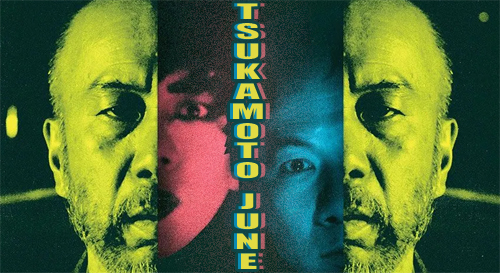
Available from Third Window on Blu-ray and on Demand
As the title character arrives with a lot of discordant classroom instruments, a few dance moves, and some screaming, it seems clear that this isn’t just another Tsukamoto movie. Even if the man himself is in the film and like Gemini the top billed cast also includes a music star. There’s also another descent into madness (or hell) and another painful relationship like the ones his earlier features. However, as things unfold this becomes the director at his most atypical, without the technological metaphors or even the Chu Ishikawa tunes. These kind of stylish touches would only serve to make this less disturbing. Here the nightmare happens in broad daylight and seems like a documentary, complete with a narrator, about the life of someone trapped by problems conjured up by their own mind. Any moments of dark comedy or fantasy are fleeting in a story that is more an endurance test than a macabre thriller.
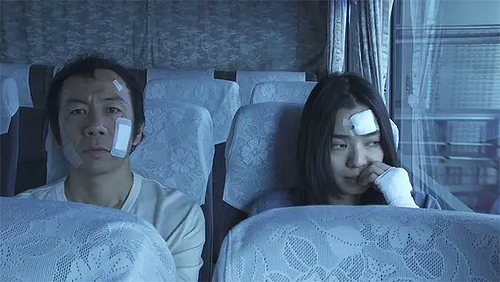
There’s no inciting incident for the mental health problems that Kotoko (Cocco) lives with. Her childhood is shown as a single sequence at the start like a long lost memory, before it becomes clear that she’s lived with waking nightmares and has been self-harming for a long time. The paranoid hallucinations take the form of doubles of people, one friendly and one not, who try to attack her and her son Daijiro. It’s hard to say which aspect of this is more unsettling; the violent visions, or the fact that her baby is often at the centre of their repercussions. The traditional aspects of a ‘child in peril’ storyline are absent as the unvarnished reality takes centre stage. After moving home more than once there’s a desperation and sadness that goes beyond the crying child and Kotoko’s frequently unreliable narration. The loneliness of a single parent unable to cope with all of this compounds an already harrowing situation.
There’s far too much singing in the film but it signals when things will be less unpredictable. Never before has a pan of fried vegetables been so upsetting. Neighbours trying to make conversation about Daijiro being cute and men trying to coerce Kotoko with a drink face violent outbursts. The local authorities are made intentionally faceless but their eventual arrival is at least some respite. Never before has an unseen figure banging on a door been such a relief. Kotoko claims that song and dance offer a way for her to relax and overcome her issues. But it’s only when her family steps in to care for the baby, because of official intervention, that any sense of ease arrives. The frustration and despair melt away and are replaced by rural scenery and colourful craft paper. But like all of the quieter (and friendlier) moments this is a temporary state of affairs. The real horror is that Kotoko may never be cured.
Left without her child the story, at least briefly, veers into the director’s usual domain. As the lines between truth and nightmare blur Kotoko meets famed novelist Tanaka (Shinya Tsukamoto). Is this part of her delusion about the news stories she watches or is he a stalker? Is this itself real or another imagined attacker? There’s no double-vision this time around but his behaviour is certainly odd. ‘I laughed,’ says Kotoko to herself after he proposes… though in reality she doesn’t even smile. She also admits that she doesn’t read books and it’s unclear if doing so helps when she finds his latest release. She decides that becoming happy is possible when her loneliness is abated. But their friendship is volatile and Tanaka’s face is covered with golf ball sized lumps after trying to help. Her wrist cutting seems more intense but her visions of persecution seem to end. But there will be no fairytale ending and no easy rehabilitation.
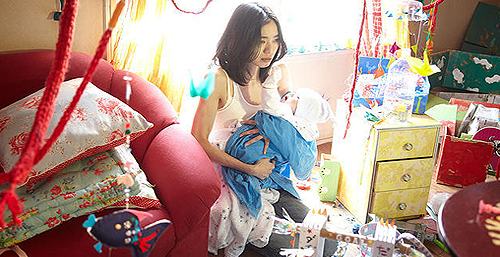
Kotoko’s awkward singing continues on as the inverted ‘manic dream’ cliché of finding a perfect partner feels more and more phony. A sad character meeting an upbeat one and having their life changed often feels like a naive approach to romantic writing, so this feels more like a darkly comedic take on such a tale. The entire trope is utterly smashed by the time Tanaka’s latest beating comes around. Is this a fantasy or a continuation of the same nightmare? The story seems more concerned with the pain of such a scenario; from the domestic abuse to the illnesses involved. Scenes of levity are increasingly brief and eccentric moments are few and far between, though they do exist. A sequence in which Tanaka tries to help Kotoko, after breaking in to the apartment, stands out as one of the few moments that might become farcical the longer it goes on.
But even Kotoko’s primary coloured world of drawing pencils and origami cranes starts to become a claustrophobic trap during the finale. There seem to be cruel moments towards the end when things are almost on the verge of improving, when really it’s just the start of another layer of darkness. There are visions of beauty as her mind breaks down, and there is occasional tenderness. Cocco’s central performance is pretty compelling for a first foray into the world of acting, while Tsukamoto brings his awkward and endearing persona. It’s hard to call this a romantic comedy but there are elements of that genre occasionally at work. However, be warned that this is also the film-maker’s most distressing feature when the bleak nature of the situation comes to a head. If you’ve wondered whether watching too many TV news stories about crime and war is bad for your state of mind then he offers a very direct opinion here.
It’s not an entirely hopeless story but it is one that will leave some viewers feeling shell-shocked. Even those who feel desensitized to extreme cinema. This time all the monsters are internalised and things are about to get a lot worse before they get better. It’s a brief movie but at times it does seem as though there’s long way to go. It does at least have a lot of contrasting moods along the way. Music and dance, art and literature, and of course family gatherings, are depicted as being wholesome forces in opposition to a dark and cold world. But these kind of heartfelt sequences aren’t shown to be cure-alls for serious conditions. Which is refreshing, if bleak. The sparse music and the tortured characters replace the punk aesthetics of Tsukamoto’s earlier features, while all notions of cliché and cuteness have been totally stripped out. The result is perhaps his most realistic, and certainly most challenging, horror film.
Rating: 









Further Reading:
Previously on Tsukamoto June:

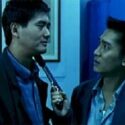
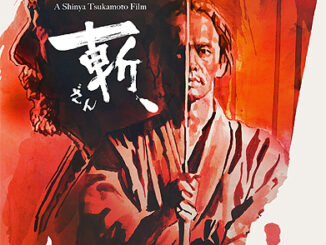

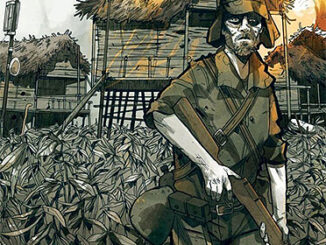
Be the first to comment